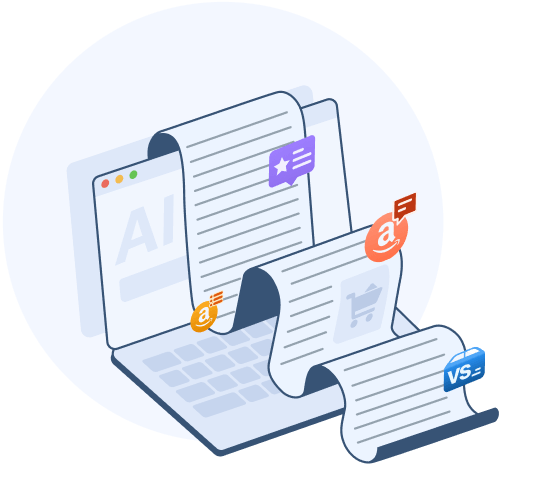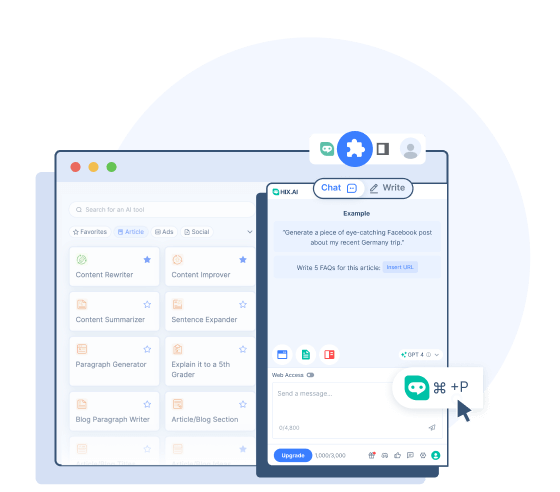Hello. It’s great to meet you. We’d like to introduce you to this guide about how to write introduction emails. Step this way…
The ability to write introduction emails is a skill anyone can develop. If you’re starting out at work or a mid-career pro, we’ll help you communicate more clearly and build critical connections.
We’re going to school you in the ways of introductions. Get ready for 5 sample introduction emails covering (almost) all types of professional introductions, including how to:
- Introduce yourself email
- Introduce a new colleague email
- Introduce colleague to client email
- Introduce a friend to another friend email
- Professional work introduction email
We've also created an essential guide with a step-by-step breakdown to help you write effective introduction emails. By the end of this article, you'll be better connected than ever before
Unlock the Power of AI for Your Email Introductions
Before exploring our expertly crafted samples, streamline your workflow by using our free AI email generator to effortlessly create effective introductory emails tailored to your needs.
What are introduction emails?
Introduction emails bring together two people who have never met before but have a connection. You'll want to send an email introduction when you're new to a role to help people know who you are.
Introduction emails are also used to bring together people. That could be a new colleague to a boss, a colleague to a customer, or two professionals to each other.
While there is an almost infinite range of reasons you'll want to send an introduction email, we've created 5 samples to show how it's done.
5 introduction email samples
Here are 5 introduction email samples covering several everyday situations you may encounter personally and professionally. Let's get writing!
Introduce yourself email
If you are new to the team or a group of people, you might need to send an email introducing yourself and your role. This message aims to provide some information about you (name, start date, job role, etc.) to create a connection.
Dear [Recipient's Name],
My name is [Your Name] and I am writing to introduce myself as the newest member of the team. I recently joined the company on [Start Date] and I am excited to be part of this dynamic group.
As for my role, I will be serving as [Job Role]. I have over [Number] years of experience in this field, and I am confident that my skills and expertise will contribute positively to the team's objectives.
I am eager to get to know each of you and learn more about your roles and projects. In the upcoming days, I would appreciate the opportunity to have individual meetings with each team member to gain a better understanding of our collective goals and how I can align my work accordingly.
Please feel free to reach out to me if you have any questions or if there is anything specific you would like for me to know about your work. I am looking forward to working together and achieving great results.
Thank you for your attention.
Best regards,
[Your Name]
Introduce a colleague to a new boss email
This type of email is used to introduce a new member of your team or organization to the rest of the group or an individual to a boss (it can do both!). This is a brief email that enables the individual to send a follow-up.
Dear [Recipient's Name],
I am pleased to introduce [Colleague's Name] who has recently joined our team as [Colleague's Position]. [Colleague's Name] brings [briefly mention their experience or skills related to the role]. I am confident that [Colleague's Name] will make significant contributions to our team and organization.
[Colleague's Name], please feel free to reach out to [Recipient's Name] for any assistance or information regarding [describe the area or tasks the colleague will be handling]. I am sure [Colleague's Name] will prove to be a valuable asset to our team.
Thank you for your attention.
Best regards,
[Your Name]
HIX Email WriterWrite/Reply to Emails Instantly
Type // to draft emails in no time
Get tailored replies with one click
Quickly summarize a received email
Read also: How to Ask for a Raise via Email
Introduce colleague to client email
This email introduces a colleague who will be working with a particular client, usually to provide them with support or service. The idea here is to provide a personal introduction and provide the client with confidence that their account will continue to be supported and delivered.
Dear [Recipient's Name],
I hope this email finds you well. I would like to take this opportunity to introduce you to my colleague, [Colleague's Name]. [Colleague's Name] will be working closely with you to provide support and deliver the services you require.
[Colleague's Name] has over [number] years of experience in [relevant field] and has a strong track record of successfully assisting clients like yourself. I have full confidence in [Colleague's Name]'s ability to meet your needs and provide you with the level of support you expect.
Please feel free to reach out to [Colleague's Name] directly at [Colleague's Email] or [Colleague's Phone Number] for any assistance you may require. [Colleague's Name] is looking forward to working with you and ensuring a seamless continuation of our services.
Thank you for your attention.
Best regards,
[Your Name]
Read also: How to introduce yourself in an email (5 examples)
Introduce friend to another friend email
The samples so far have focused on professional introductions. However, you might also want to introduce two friends or professional connections who could benefit. This friendly and informal email is perfect for that purpose.
Dear [Recipient's Name],
I hope this email finds you well. I am writing to introduce you to my friend, [Friend's Name]. I believe that you both share similar interests in [common interest or field of work]. [Friend's Name] is an expert in [describe their expertise or experience] and I think you two would benefit from connecting and exchanging ideas.
I have cc'ed [Friend's Name] on this email so that you can directly get in touch with each other. I encourage you to reach out and explore potential collaborations or simply have a friendly chat.
Thank you for your attention and I hope you both find value in this introduction.
Best regards,
[Your Name]
Read also: How to start an email? (10 email greetings examples included)
Professional work introduction email
This type of email is used to introduce yourself or someone else for networking purposes. This can be useful when job hunting, seeking new clients, or asking for professional advice. It's super-formal, 100% professional, and sticks to the format!
Dear [Recipient's Name],
I hope this email finds you well. I am writing to introduce myself and express my interest in networking with you.
I have over 10 years of experience in various roles, including [mention relevant experience]. I am dedicated to professional growth and always seeking opportunities to connect with individuals in my field.
If you have any advice or insights you could share, I would greatly appreciate it. I am also open to discussing potential collaborations or any other opportunities you may have in mind.
Thank you for your attention.
Best regards,
[Your Name]
Expert guide on how to write introduction emails
Samples are great, but unless you’re simply going to steal them it’s time to help you write your own. So, you want great introduction emails but don't know where to start? This expert guide breaks down messages, showing you the correct format and everything you must feature.
All the best (and some of the worst) introduction emails work in this logical and linear way:
- Outline who you are and why you're messaging
- Introduce the person
- Provide some details and context
- Add contact details and encourage them to connect
Boring? No. Business-like? Absolutely. Introduction emails are formal messages with a shared structure and a standard format. We've broken this into 3 parts:
- Subject line
- Body copy
- Sign-off/next steps
We begin with the intro email subject lines...
Introductory email subject lines
Every great introduction email needs a superb subject line. The purpose of the subject line is to grab attention and encourage a click. The secret to achieving this is incorporating as much of this as possible.
Want to see how this works? Read our samples and get started!
- Introducing you to (person’s name)
- I would like to introduce you to (person’s name)
- (Person’s name) – Introducing you!
- I wanted to connect you with (person’s name)
- Have you ever met (person’s name)
- (Person’s name) has a project they want to discuss!
- Can I connect you with (person’s name)
- You would value from meeting (person’s name)
- Are you free to chat with (person’s name)
- Welcoming (person’s name) to the team
- It’s (person’s name) first day - please say hi
- Hello to (person’s name) on their first day!
Introductory email body copy
Introduction emails are short, clear, and follow a common structure. The purpose of your email is to provide enough information as required by the audience.
It's easy to achieve this if you stick with the structure we outlined above.
Before we get into the details, begin each email with a personalized greeting to the person you're messaging. Start with a "Hi (person's name)," and then work through the following structure as we do below. This email aims to introduce a colleague to a trusted customer.
- Outline who you are and why you're messaging
"It's (your name) from (company name). We've worked together for a long time now, but I will be leaving and wanted to introduce you to my colleague taking over the account.”
- Introduce the person
"(Person's name) has joined us from (where they're from) and has (number) of years of professional experience. They are more than capable of continuing to deliver a great service."
- Provide some details and context
"My last day at (company name) is (insert date), and they'll be taking charge of the account from then on."
Also find out: How to start an email?
Introductory email sign-off/next steps
If you've worked through the list here, we now have an excellent intro email. The next stage is to create the connection and back out of the process.
- Add contact details and encourage them to connect
"I've copied (person's name) into this email, and they'll be in touch shortly to set up a call or a meeting. I wish you all the best for the future."
To finish off the email, add a sign-off ("thanks," "many thanks," etc.) as well as your name, signature, and contact details. Then hit send, and your intro is done!
Pro tips for how to write an introduction email
By now you’re probably thinking you’ve got everything you need to write introduction emails. You may even have secretly written and sent one. (If so, how did it go?)
It’s true that sticking to the email format is essential in writing intro emails, but there’s more to it than that. Perfect introduction emails are 4 things.
- Personalized
- Targeted
- Value-driven
- Accurate
The acronym PTVA isn’t particularly exciting, but it’s essential you remember the points. Let's go through each in order.
Personalized emails get results. They go beyond the superficial, and establish connections by appealing to the individual. You’ll need to use first names, provide shared reference points, and appeal to the things that you know motivate them. It’s about creating an emotional connection!
Introductory emails aren’t basic, they’re targeted. That means they’re focused, details, accurate, and engaging (by that, we mean not boring!). Don’t sit there and type aimlessly, have a focus on your message!
We’re all inherently selfish and want to know what we’re going to get out of an interaction. You can define this as value, and it’s essential to include it in every message. Inside every Introductory email tell both sides what they can get out of the interaction and ongoing relationship.
You’ve got this far, now, don’t let yourself down with mistakes, inaccuracies, and errors. Always check every message, ensure attachments are attached, and contact details are all up-to-date. Don’t just trust yourself, use an online spelling and grammar checker to get it right 100% of the time.
If you’re searching for the words but they’re just not coming, try our AI email generator. This advanced AI program can create word-perfect Introductory emails (or any emails!) faster than ever before. It can generate messages you can use immediately or shape around your requirements.
Conclusion
We’d like to introduce you to the end of the internet’s best guide to writing intro emails. How are you feeling now? We hope that you’re feeling confident at writing Introductory emails, and that you’re more than familiar with the format.
To start out, stick to the format and follow the formula here, and you'll help to build connections among colleagues, professionals, and personal friends. Keep messages short, use precise language, and always proofread! Take your messages to the next level by following our pro tips (or sit back, relax, and let HIX.AI do the hard work!).



